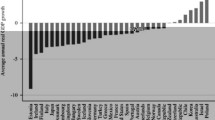Abstract
The prevalent view is that the current credit crisis has its origin in the bust of the housing bubble. But what is missing from this view is that the finance of a bubble is only possible through a corresponding increase in credit — no credit, no bubble. Thus at the heart of the current woes lies the excessive liquidity that was put in place in the last ten years or so.3 This liquidity financed in the first instance the internet bubble, but because there was no deleverage following the burst of this bubble the liquidity went on to finance other bubbles, including housing, private equity and commodities. Thus, the housing bubble is a transformation of the previous internet bubble.
Access this chapter
Tax calculation will be finalised at checkout
Purchases are for personal use only
Preview
Unable to display preview. Download preview PDF.
Similar content being viewed by others
References
Arestis, P. (2007) What is the New Consensus in Macroeconomics?, chapter 2 in P. Arestis (ed.), Is There a New Consensus in Macroeconomics?, Basingstoke: Palgrave Macmillan.
Arestis, P. and E. Karakitsos (2004) The Post-Bubble US Economy: Implications for Financial Markets and the Economy, Basingstoke: Palgrave Macmillan.
Arestis, P. and M. Sawyer (2003) Reinstating Fiscal Policy, Journal of Post Keynesian Economics, 26 (1), 3–25.
Bank of England (2008) Financial Stability Report, No. 23, April.
Bank of International Settlements (BIS) (2008) Annual Report, June.
Eisinger, J. (2008) London Banks, Falling Down, downloadable from: http://www.portfolio.com/views/columns/wall-street/2008/08/13/Problems-inBritish-Banking-System
Gorton, G.B. (2008) The Panic of 2007, NBER Working Paper Series, No. 14358, National Bureau of Economic Research: Cambridge, MA.
King, M. (2005) Monetary Policy: Practice Ahead of Theory, Mais Lecture, Cass Business School, City University, London.
Listokin, D., E. Wyly, L. Keating, K. Rengert and B. Listokin (2000) Making New Mortgage Markets: Case Studies of Institutions, Home Buyers and Communities, Fannie Mae Foundation Research Report.
Author information
Authors and Affiliations
Editor information
Editors and Affiliations
Copyright information
© 2009 Philip Arestis and Elias Karakitsos
About this chapter
Cite this chapter
Arestis, P., Karakitsos, E. (2009). Subprime Mortgage Market and Current Financial Crisis. In: Arestis, P., Mooslechner, P., Wagner, K. (eds) Housing Market Challenges in Europe and the United States. Palgrave Macmillan, London. https://doi.org/10.1057/9780230246980_3
Download citation
DOI: https://doi.org/10.1057/9780230246980_3
Publisher Name: Palgrave Macmillan, London
Print ISBN: 978-1-349-31038-8
Online ISBN: 978-0-230-24698-0
eBook Packages: Palgrave Economics & Finance CollectionEconomics and Finance (R0)




